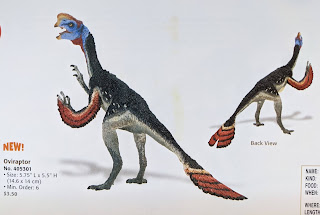The Carnegie Collection Oviraptor (2007)
Species: Oviraptor philoceratops
First release: 2007
Retired: 2015
Model number: 4053-01
Size: 15cm
Scale: 1:10
Sculptor: Forest Rogers
It is interesting to note that, like the original Carnegie Oviraptor model, this is one of the few "Oviraptor" figures available that is not clearly based on Citipati. The crest of this model is similar to Citipati osmolskae, but not an exact match, and it is not based on the "classic" version of Oviraptor, the Zamyn Kont species known as "Citipati sp.".
Version: 1
Release: 2007
Status: Resculpt, major repaint
Material: Hard gray vinyl
Paint: Matte. 7 colors.White (spots, stripes, underside of feathers); black (back, stripes, claws); red (wing, tail feathers, throat); yellow (crest, beak); blue (head); pink (mouth, coverts); gold (eyes); gray (skin wash).
Stamp text: Left-aligned. On tail. Oviraptor / (C) 2006 Safari Ltd., Miami, FL USA / Made in China / CE
CE mark: Large
TDR rating: 3/10
The second Carnegie Oviraptor is probably the fastest "remake" ever done in the line. It must have been remolded, rather than just retooled, to add an appropriate amount of feathering compared to the under-feathered 2005 original, and as a result it was given a distinct model number. It seems likely that Forest Rogers would have added sculpted wing and tail feathers onto her original polymer model, and had the model re-cast in resin and a new mold made. The sculpt of the model is otherwise identical to the original, but there is no sign of an erased belly stamp when it moved to the tail, indicating that a new mold was made which then received a new stamp. So this model blurs the line between a "resculpt" and a "remake". Since it has a new model number, I list it as the latter.
Some online sources list this Oviraptor as a "male" and the other as a "female", though they were not labelled this way and, scientifically, this makes little sense as the larger wing feathers used for egg brooding would be more necessary on a female rather than a male. I suspect the fan explanation is simply a desire not to have been asked to buy an inaccurate model so soon after its replacement, and the idea that the brighter colors would indicate a male individual (of course, the absence of wing and tail feathers, not the coloration, is the primary difference here). Rather than representing an intentionally dimorphic pair, like the Australopithecus set, this second Oviraptor was clearly meant to replace the botched original.







Comments
Post a Comment